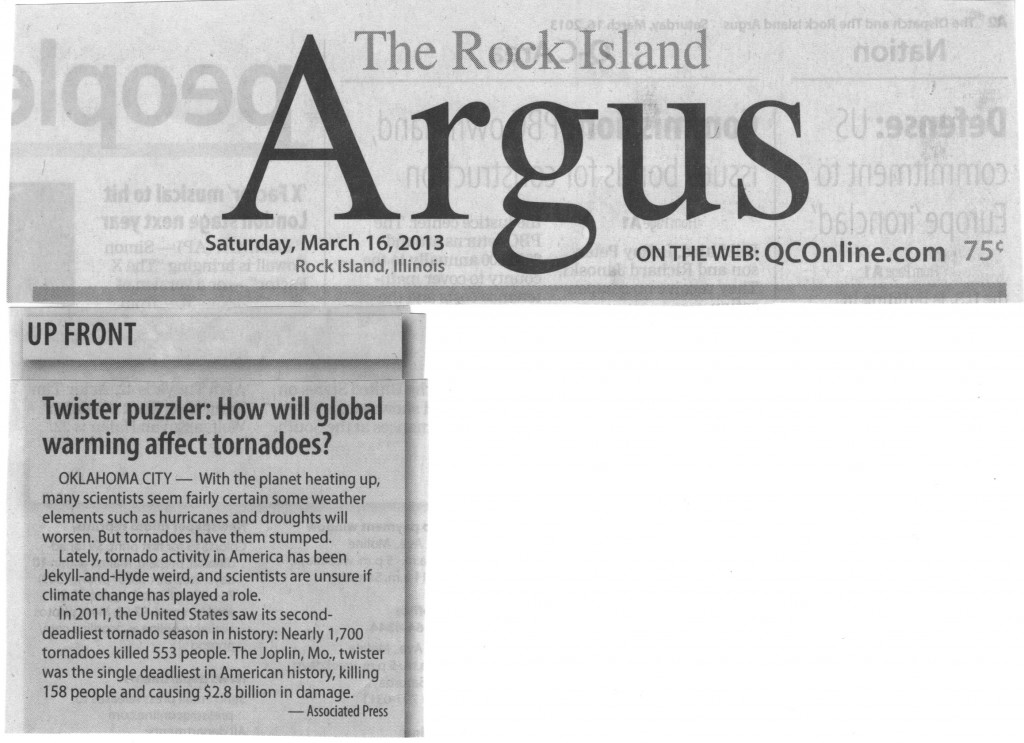Tornado Story Phony When It Isn’t False
The story above appeared on the front page of The Argus – Dispatch on Saturday. It had an AP byline which the A-D picked up. That aspect does not exonerate the A-D even if they want to maintain that all they are responsible for knowing is what they read in the papers i.e., the AP. It is journalistic malpractice for either or both organizations to propagate the bowdlerization of science for political purpose, which we believe at bottom is what this is all about.
“Lately, tornado activity in America has been Jekyll and -Hyde weird” is a statement not supported by an objective understanding of the available data. Concerted record keeping did not begin until 1950. The Fujita F-scale has been agreed upon to help make strength estimates comparable however the technology and methodologies of detecting tornadoes have only been implemented more recently. With improving technology and methodology the tornado numbers go up for that reason alone.
The issue of deadly tornado seasons as raised in the AP – Argus article also has no dependable relationship to anything suggested. A NOAA chart of Tornadoes by F-scale does not appear by our reading to show any Jekyll-and -Hyde aspect for those rated F-5, F-4 or F-3, the designations for the most destructive tornadoes.
F-4 or even F-3 tornadoes can be more deadly than an F-5 if the F-5 lands somewhere sparsely populated (as most tornadoes do). Also consider the following as reported at tornadoproject.com, which makes use of National Oceanic and Atmospheric Administration (NOAA) data.
The United States gets about 1000 recorded tornadoes every year. Today, only a few are killers, but that has not always been so. About 200 US tornadoes have killed 18 or more people. Of those, about 150 occurred in the 70 year period between 1879 and 1949. There have been about 45 tornadoes since 1950 that have killed 18 or more people. In the 1950s, there were 18 tornadoes that killed 18 or more people. In the 1960s, there were 12 tornadoes that killed 18 or more people. In the 1970s,there were 11 tornadoes that killed 18 or more people. And in the 1980s, there were only 2 tornadoes that killed more than 18 people. In spite of an ever-burgeoning population, death figures continue to go down as improved forecasting, detection, communications, and public awareness increase.
The A-P / A-D article is also in error in stating that the 2011 tornado season was the second deadliest in history and that the Joplin, Missouri twister was “the single deadliest in American history, killing 158 people . . .” The NOAA website clearly indicates that there were six widely spaced more deadly tornado seasons and six more individually deadly tornadoes. In order of carnage: 1925 – Tri-State 695 deaths; 1840 – Natchez MS, 317 deaths; 1896 – St Louis MO, 255 deaths; 1936 – Tupelo, MS, 216 deaths; 1936 – Gainesville GA, 203 deaths; and 1947 – Woodward, OK, 181 deaths. Here is still another link to a story from the Examiner, which provided the NOAA based information in a timely manner just after the 2011 Joplin destruction and deaths.
It is a sad situation when professional journalists can get such readily checkable facts wrong and then pretend meaningfulness to other data when there is none, all under a distorted premiss, in this case that global warming is a significant actuality. To promulgate the same not only makes for “low information” citizens, worse, it makes for others who do not know what they do not know, who then vote to support overwrought environmental policies that have wide ranging negative effects on economies, hurting all but especially the poorest.
R Mall


Wow that is some serious ownage! Good work sir.